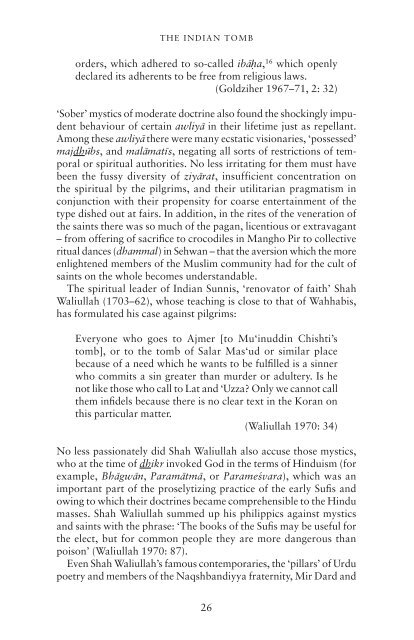Muslim Saints of South Asia: The eleventh to ... - blog blog blog
Muslim Saints of South Asia: The eleventh to ... - blog blog blog
Muslim Saints of South Asia: The eleventh to ... - blog blog blog
You also want an ePaper? Increase the reach of your titles
YUMPU automatically turns print PDFs into web optimized ePapers that Google loves.
THE INDIAN TOMB<br />
orders, which adhered <strong>to</strong> so-called ibāh˛a, 16 which openly<br />
declared its adherents <strong>to</strong> be free from religious laws.<br />
(Goldziher 1967–71, 2: 32)<br />
‘Sober’ mystics <strong>of</strong> moderate doctrine also found the shockingly impudent<br />
behaviour <strong>of</strong> certain awliyā in their lifetime just as repellant.<br />
Among these awliyā there were many ecstatic visionaries, ‘possessed’<br />
majdhūbs, and malāmatīs, negating all sorts <strong>of</strong> restrictions <strong>of</strong> temporal<br />
or spiritual authorities. No less irritating for them must have<br />
been the fussy diversity <strong>of</strong> ziyārat, insufficient concentration on<br />
the spiritual by the pilgrims, and their utilitarian pragmatism in<br />
conjunction with their propensity for coarse entertainment <strong>of</strong> the<br />
type dished out at fairs. In addition, in the rites <strong>of</strong> the veneration <strong>of</strong><br />
the saints there was so much <strong>of</strong> the pagan, licentious or extravagant<br />
– from <strong>of</strong>fering <strong>of</strong> sacrifice <strong>to</strong> crocodiles in Mangho Pir <strong>to</strong> collective<br />
ritual dances (dhammal) in Sehwan – that the aversion which the more<br />
enlightened members <strong>of</strong> the <strong>Muslim</strong> community had for the cult <strong>of</strong><br />
saints on the whole becomes understandable.<br />
<strong>The</strong> spiritual leader <strong>of</strong> Indian Sunnis, ‘renova<strong>to</strong>r <strong>of</strong> faith’ Shah<br />
Waliullah (1703–62), whose teaching is close <strong>to</strong> that <strong>of</strong> Wahhabis,<br />
has formulated his case against pilgrims:<br />
Everyone who goes <strong>to</strong> Ajmer [<strong>to</strong> Mu‘inuddin Chishti’s<br />
<strong>to</strong>mb], or <strong>to</strong> the <strong>to</strong>mb <strong>of</strong> Salar Mas‘ud or similar place<br />
because <strong>of</strong> a need which he wants <strong>to</strong> be fulfilled is a sinner<br />
who commits a sin greater than murder or adultery. Is he<br />
not like those who call <strong>to</strong> Lat and ‘Uzza? Only we cannot call<br />
them infidels because there is no clear text in the Koran on<br />
this particular matter.<br />
(Waliullah 1970: 34)<br />
No less passionately did Shah Waliullah also accuse those mystics,<br />
who at the time <strong>of</strong> dhikr invoked God in the terms <strong>of</strong> Hinduism (for<br />
example, Bhāgwān, Paramātmā, or Parame´svara), which was an<br />
important part <strong>of</strong> the proselytizing practice <strong>of</strong> the early Sufis and<br />
owing <strong>to</strong> which their doctrines became comprehensible <strong>to</strong> the Hindu<br />
masses. Shah Waliullah summed up his philippics against mystics<br />
and saints with the phrase: ‘<strong>The</strong> books <strong>of</strong> the Sufis may be useful for<br />
the elect, but for common people they are more dangerous than<br />
poison’ (Waliullah 1970: 87).<br />
Even Shah Waliullah’s famous contemporaries, the ‘pillars’ <strong>of</strong> Urdu<br />
poetry and members <strong>of</strong> the Naqshbandiyya fraternity, Mir Dard and<br />
26


